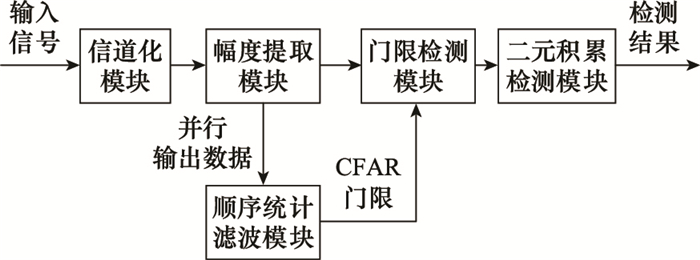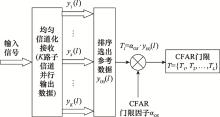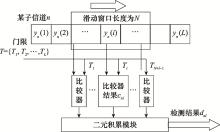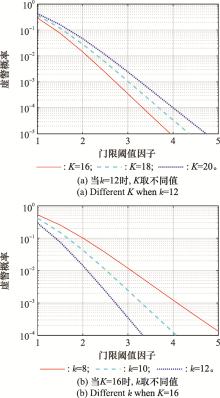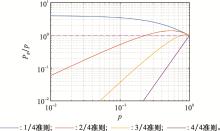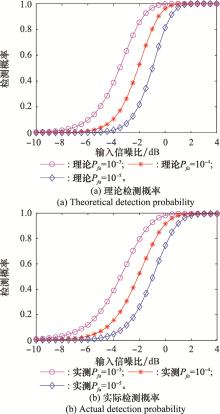Systems Engineering and Electronics ›› 2022, Vol. 44 ›› Issue (4): 1085-1092.doi: 10.12305/j.issn.1001-506X.2022.04.03
• Electronic Technology • Previous Articles Next Articles
Radiation source signal detection method based on ordered statistical filtering and binary accumulation
Zhongkai ZHAO1,2,*, Hao GONG1, Ran ZHANG3
- 1. School of Information and Communication Engineering, Harbin Engineering University, Harbin 150001, China
2. Key Laboratory of Advanced Ship Communication and Information Technology, Ministry of Industry and Information Technology, Harbin Engineering University, Harbin 150001, China
3. Beijing Aerospace Long March Aircraft Research Institute, Beijing 100076, China
-
Received:2021-04-13Online:2022-04-01Published:2022-04-01 -
Contact:Zhongkai ZHAO
CLC Number:
Cite this article
Zhongkai ZHAO, Hao GONG, Ran ZHANG. Radiation source signal detection method based on ordered statistical filtering and binary accumulation[J]. Systems Engineering and Electronics, 2022, 44(4): 1085-1092.
share this article
| 1 |
CHALISE B K , AMIN G , HIMED B . Performance tradeoff in a unified passive radar and communications system[J]. IEEE Signal Processing Letters, 2017, 24 (9): 1275- 1279.
doi: 10.1109/LSP.2017.2721639 |
| 2 |
ZAIMBASHI A . A unified framework for multistatic passive radar target detection under uncalibrated receivers[J]. IEEE Trans.on Signal Processing, 2021, 69, 695- 708.
doi: 10.1109/TSP.2020.3048800 |
| 3 | ZHANG Y B, CHAI H, WANG J F. Implementation and comparison of signal detection methods in radar reconnaissance system[C]//Proc. of the IEEE 3rd International Conference on Electronic Information and Communication Technology, 2020: 75- 79. |
| 4 | GUO R C, HE K, YANG G, et al. Noncoherent accumulation algorithm of non-cooperative radiation source radar signals based on dynamic programming[C]//Proc. of the International Confe-rence on Computer Vision, Image and Deep Learning, 2020: 633- 636. |
| 5 |
JIANG X L , DIAO M , QU S S . Signal detection algorithm design based on stochastic resonance technology under low signal-to-noise ratio[J]. Journal of Shanghai Jiao Tong University (Science), 2019, 24 (3): 328- 334.
doi: 10.1007/s12204-019-2071-9 |
| 6 | ABINAYA R, VARSHA V, VELMURUGAN P G S. Gra-dient-based real-time radar pulse detection at low SNR[C]//Proc. of the International Conference on Wireless Communications, Signal Processing and Networking, 2016: 2156-2159. |
| 7 |
HEJAZIKOOKAMARI F , NOROUZI Y , KASHANI E S , et al. A novel method to detect and localize LPI radars[J]. IEEE Trans.on Aerospace and Electronic Systems, 2019, 55 (5): 2327- 2336.
doi: 10.1109/TAES.2018.2885109 |
| 8 |
WAN T , JIANG K L , LIAOY L , et al. Detection and recognition of LPI radar signals using visibility graphs[J]. Journal of Systems Engineering and Electronics, 2020, 31 (6): 1186- 1192.
doi: 10.23919/JSEE.2020.000091 |
| 9 | CHEN X L, GUAN J, HUANG Y, et al. Radar signal processing for low-observable marine target-challenges and solutions[C]//Proc. of the IEEE International Conference on Signal, Information and Data Processing, 2019. |
| 10 |
NIE D H , XIE K , ZHOU F , et al. A correlation detection method of low SNR based on multi-channelization[J]. IEEE Signal Processing Letters, 2020, 27, 1375- 1379.
doi: 10.1109/LSP.2020.3013769 |
| 11 |
HAN S D , YAN L J , ZHANG Y X , et al. Adaptive radar detection and classification algorithms for multiple coherent signals[J]. IEEE Trans.on Signal Processing, 2021, 69, 560- 572.
doi: 10.1109/TSP.2020.3047523 |
| 12 | 户盼鹤, 鲍庆龙, 陈曾平. 基于概率直方图的被动雷达弱目标检测方法[J]. 系统工程与电子技术, 2018, 40 (6): 1227- 1232. |
| HU P H , BAO Q L , CHEN Z P . Detection method of passive radar weak targets based on probability histogram[J]. Systems Engineering and Electronics, 2018, 40 (6): 1227- 1232. | |
| 13 | AL-BADRAWI M H, KIRSCH N J, AL-JEWAD B Z. An intrinsic mode function-based energy detector for spectrum sensing in cognitive radio[C]//Proc. of the International Conference on Computing, Networking and Communications, 2017: 131- 136. |
| 14 | 夏双志, 戴奉周, 刘宏伟. 复高斯白噪声背景下贝叶斯检测前跟踪的检测阈值设置方法[J]. 电子与信息学报, 2013, 35 (3): 524- 531. |
| XIA S Z , DAI F Z , LIU H W . A method of determining detection threshold for Bayesian track-before-detection in white complex Gaussian noise[J]. Journal of Electronics and Information, 2013, 35 (3): 524- 531. | |
| 15 |
FAN X Y , SHANG S , SONG D W , et al. Weak target detection technology of passive radar on the navigation satellite signal[J]. The Journal of Engineering, 2019, 2019 (20): 6671- 6674.
doi: 10.1049/joe.2019.0127 |
| 16 | ZHOU X X, CAI Q W, WANG Z, et al. Efficient design and implementation of channelized reconnaissance receiver[C]//Proc. of the 4th International Conference on Communication and Information Processing, Association for Computing Machinery Press, 2018: 294-298. |
| 17 |
龚仕仙, 魏玺章, 黎湘. 宽带数字信道化接收机综述[J]. 电子学报, 2013, 41 (5): 949- 959.
doi: 10.3969/j.issn.0372-2112.2013.05.019 |
|
GONG S X , WEI X Z , LI X . Review of wideband digital channelized receivers[J]. Acta Electronica Sinica, 2013, 41 (5): 949- 959.
doi: 10.3969/j.issn.0372-2112.2013.05.019 |
|
| 18 | ZHANG W X, SHI F M, LIU T, et al. Model of non-leaking-alarms and non-aliasing channelized digital receiver[C]//Proc. of the 6th International Conference on Instrumentation & Measurement, Computer, Communication and Control, 2016: 994-997. |
| 19 | 刘光祖, 王建新, 徐达龙. 数字信道化接收机高效结构的设计与实现[J]. 系统工程与电子技术, 2012, 34 (2): 391- 395. |
| LIU G Z , WANG J X , XU D L . Design and implementation of efficient structure for digital channelized receivers[J]. Systems Engineering and Electronics, 2012, 34 (2): 391- 395. | |
| 20 | NAMGOONG W . A channelized digital ultrawideband receiver[J]. IEEE Trans.on Wireless Communications, 2015, 2 (3): 502- 510. |
| 21 |
ORLOV I Y , FITASOV E S . Estimation of loss when detecting signals by a receiver with adaptive threshold on the basis of the method of ordered statistics[J]. Radiophysics and Quantum Electronics, 2018, 61 (7): 528- 535.
doi: 10.1007/s11141-018-9913-4 |
| 22 |
ONUMANYI A J , BELLO-SALAU H , ADEJO A O , et al. A discriminant analysis-based automatic ordered statistics scheme for radar systems[J]. Physical Communication, 2020, 43, 101215.
doi: 10.1016/j.phycom.2020.101215 |
| 23 | RICHARDS M A. 雷达信号处理基础[M]. 2版. 邢孟道, 王彤, 李真芳, 等译. 北京: 电子工业出版社, 2017: 263-265. |
| RICHARDS M A. Fundamentals of radar signal processing[M]. 2nd ed. XING M D, WANG T, LI Z F, et al. Trans. Beijing: Electronic Industry Press, 2017: 263-265. | |
| 24 | 罗勇江, 汤建龙, 赵国庆, 等. 一种高效的宽带数字接收机及其FPGA实现[J]. 系统工程与电子技术, 2010, 32 (5): 916- 920. |
| LUO Y J , TANG J L , ZHAO G Q , et al. An efficient wideband digital receiver and its FPGA implementation[J]. Systems Engineering and Electronics, 2010, 32 (5): 916- 920. | |
| 25 |
ZHANG W X , YAO Y S , ZHAO Z K , et al. Design and FPGA implementation of a novel efficient FRM-based channelized receiver structure[J]. IEEE Access, 2019, 7, 114778- 114787.
doi: 10.1109/ACCESS.2019.2935562 |
| 26 | 刘寅, 黄秀琼, 王亚涛. 波形对数字信道化接收机测频性能影响分析[J]. 电子与信息学报, 2017, 39 (10): 2531- 2535. |
| LIU Y , HUANG X Q , WANG Y T . Analysis of the influence of waveform on the frequency measurement performance of digital channelized receivers[J]. Journal of Electronics and Information Technology, 2017, 39 (10): 2531- 2535. | |
| 27 | LIU X Q, LI T, SU S Y, et al. Signal detection based on recursive autocorrelation and MN method for synchronous Nyquist folding receiver[C]//Proc. of the IEEE International Conference on Signal, Information and Data Processing, 2019. |
| 28 | AKAYDIN A, UNER M K. Comparative performance analysis of constant false alarm rate processors based on order statistics[C]//Proc. of the 11th International Conference on Electrical and Electronics Engineering, 2019. |
| 29 | ELIHOS A, UNER M. Constant false alarm rate processors based on range ordered statistics[C]//Proc. of the 28th Signal Processing and Communications Applications Conference, 2020. |
| 30 |
刘维建, 谢文冲, 王永良. 多通道复信号检测中的几种常用复统计分布[J]. 电子学报, 2013, 41 (6): 1238- 1241.
doi: 10.3969/j.issn.0372-2112.2013.06.031 |
|
LIU W J , XIE W C , WANG Y L . Some complex statistical distributions in multi-channel complex-valued signal detection theory[J]. Acta Electronica Sinica, 2013, 41 (6): 1238- 1241.
doi: 10.3969/j.issn.0372-2112.2013.06.031 |
| [1] | Weiqiang YU, Fei WANG, Ping SUN, Jianjiang ZHOU, Jun CHEN. RF stealth optimization of airborne radar signal parametersunder clutter background [J]. Systems Engineering and Electronics, 2021, 43(11): 3194-3201. |
| [2] | Shengkui ZHANG, Zhicheng YAO, Min HE, Zhiliang FAN, Jian YANG. FH signal parameter blind estimation based on time-frequency variance clustering [J]. Systems Engineering and Electronics, 2020, 42(8): 1662-1667. |
| [3] | YUAN Lifen, NING Shuguang, HE Yigang, LYU Mi, LU Jian. Modulation recognition method based on high-order cumulant feature learning [J]. Systems Engineering and Electronics, 2019, 41(9): 2122-2131. |
| [4] | ZHANG Yidi, WANG Peizhi, LU Qiyong, ZHANG Jianqiu. Nonparametric detection of anomalous data with given constant false alarm rate [J]. Systems Engineering and Electronics, 2019, 41(5): 964-971. |
| [5] | WANG Zhongbao, YIN Kuiying. Beam sharpening approach based on constant false alarm rate and de-convolution [J]. Systems Engineering and Electronics, 2019, 41(12): 2738-2746. |
| [6] | ZHAO Huipeng, WANG Junling, GAO Meiguo, GUO Baofeng, MA Shaochuang. Bistatic ISAR envelope alignment algorithm based on orbit error search [J]. Systems Engineering and Electronics, 2017, 39(6): 1235-1243. |
| [7] | ZHANG Zhifu, PEI Jun, HU Chao. Generalized extended approximation algorithm for carrier estimation of burst signal [J]. Systems Engineering and Electronics, 2017, 39(6): 1215-1220. |
| [8] | LI Yun-hua1, TIAN Bin1, YI Ke-chu1, YU Quan1,2, SUN De-chun1. Novel hybrid carrier tracking loop in the case of symbol rate sampling [J]. Systems Engineering and Electronics, 2016, 38(4): 915-922. |
| [9] | WANG Shuo, ZHANG Yi-qun. Improved dynamic programming algorithm for low signal-to-noise ratio moving target detection [J]. Systems Engineering and Electronics, 2016, 38(10): 2244-2251. |
| [10] | LU Xiaoguang1,2, WU Renbiao2. Nonlinear least-squares spectral moment estimation algorithm [J]. Systems Engineering and Electronics, 2014, 36(3): 447-452. |
| [11] | GU Dan-dan, XU Xiao-jian. Fast ACCA-CFAR algorithm based on integral image for target detection from SAR images [J]. Systems Engineering and Electronics, 2014, 36(2): 248-253. |
| [12] | LIU Guangzu, WANG Jianxin, XU Dalong. Design and implementation of efficient structure for digital channelized receivers [J]. Journal of Systems Engineering and Electronics, 2012, 34(2): 391-395. |
| [13] | HOU Qiang-yu, CHEN Feng, LIU Hong-wei, BAO Zheng. Robust algorithm for radar HRRP target recognition [J]. Journal of Systems Engineering and Electronics, 2010, 32(6): 1156-1160. |
| [14] | HAO Cheng-Feng, CA Long, CHEN Mo-Jiang. Fuzzy CFAR detection for range-extended targets in Gaussian clutter [J]. Journal of Systems Engineering and Electronics, 2010, 32(4): 678-681. |
| [15] | YAN Zhen-hua, HUANG Jian-guo, HAN Jing. Improved algorithm for fast frequency estimation with short sequences at low SNR [J]. Journal of Systems Engineering and Electronics, 2009, 31(8): 1990-1992. |
| Viewed | ||||||
|
Full text |
|
|||||
|
Abstract |
|
|||||

